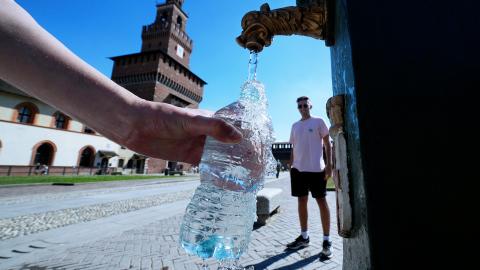
'Toxicity' in Your Water? New Study Reveals Tons of Nanoplastics from Common Source
Big questions are being raised about a primary source of drinking water for many people around the world. New research has revealed the average liter of bottled water sold in retail outlets could contain nearly a quarter million invisible pieces of tiny nanoplastics.
The groundbreaking study was released Monday by the Proceedings of the National Academy of Sciences (PNAS).
Researchers had long theorized there were lots of microscopic plastic particles in bottled water, but until researchers at Columbia and Rutgers universities did their calculations they never knew how many or what kind. The invisible bits of plastic were detected and categorized for the first time by scientists using a microscope with dual lasers.
Examining five water samples from each of three common water brands, the scientists found particle levels ranged from 110,000 to 400,000 per liter, averaging at around 240,000, according to the PNAS study.
These nanoplastics measure less than a micron in size and are invisible to the human eye. For example, there are 25,400 micros or micrometers in an inch. A human hair measures about 83 microns wide.
A lot of the plastic seems to be coming from the bottle itself and the reverse osmosis membrane filter used to keep out other contaminants, said study lead author Naixin Qian, a physical chemist at Columbia University.
The research teams did not reveal the three brands because they wanted to study more samples from the first three as well as more brands before singling out a particular brand.
Qian said the samples came from common brands bought at a Walmart.
***Please sign up for CBN Newsletters and download the CBN News app to ensure you keep receiving the latest news.***
Toxic or Not?
But the big question: Could those nanopieces be toxic to people's health?
"With engineered plastic particles with fluorescent dyes or metal labels, researchers have shown the possibility of nanoplastics crossing biological barriers and entering the biological systems, raising public concern on its potential toxicity," the study said.
The study's co-author Phoebe Stapleton, a toxicologist at Rutgers told the Associated Press, "That's currently under review. We don't know if it's dangerous or how dangerous."
"We do know that they are getting into the tissues (of mammals, including people) … and the current research is looking at what they're doing in the cells," Stapleton added.
A major article published last year in the peer-reviewed medical journal The Lancet came to this conclusion: "The growing evidence suggests that exposure to (micro and nanoplastics (MNPs)} may cause adverse effects in different human organ systems. The available literature summarized here indicates that MNPs exposure may lead to oxidative stress, inflammation, impaired immune function, alteration in cellular and energy metabolism, inhibition in cell proliferation, tissue degeneration, abnormal organ development and dysfunction, alteration in biochemical parameters and even cause genotoxicity and carcinogenicity."
The International Bottled Water Association (IBWA) pushed back against the study's findings.
"There currently is both a lack of standardized (measuring) methods and no scientific consensus on the potential health impacts of nano- and microplastic particles. Therefore, media reports about these particles in drinking water do nothing more than unnecessarily scare consumers," the IBWA said in a statement.
If the toxicity of micro and nanoplastics were universally accepted by scientists and medical professionals, it would have a major impact on the bottled water market.
In total sales, the U.S. is the largest market in the world for bottled water. In 2022, the U.S. bottled water sales volume amounted to approximately 15.9 billion gallons. This year, the Bottled Water market in the U.S. is expected to generate $100.2 billion in sales.
The American Chemistry Council, which represents plastics manufacturers, declined to comment to the AP.
Scientists have known for several years that there were tiny plastic pieces in bottled water. A study published in 2018 found more than 90% of the most popular brands of bottled water contained tiny micro fragments of plastic.
Microplastics can be found in the world's oceans, food, and drinking water, according to the United Nations Environment Programme.
"The world is drowning under the weight of plastic pollution, with more than 430 million tonnes of plastic produced annually. Two-thirds are short-lived products that soon become waste, filling the ocean and, often, working their way into the human food chain," the agency said on its website.
Outside experts, who praised the new study, agreed that there's a general unease about the perils of fine plastic particles, but it's too early to say for sure.
"The danger of the plastics themselves is still an unanswered question. For me, the additives are the most concerning," said Duke University professor of medicine and comparative oncology group director Jason Somarelli, who wasn't part of the research. "We and others have shown that these nanoplastics can be internalized into cells and we know that nanoplastics carry all kinds of chemical additives that could cause cell stress, DNA damage, and change metabolism or cell function."
Previous studies looking for microplastics and some early tests indicate there may be less nanoplastic in tap water than in bottled.
Study co-author Beizhan Yan, a Columbia environmental chemist, said he is starting to study other municipal water supplies in Boston, St. Louis, Los Angeles, and elsewhere to see how much plastics are in their tap water.
Yan said he does have one recommendation for worried people: Use reusable bottles instead of single-use plastics.




